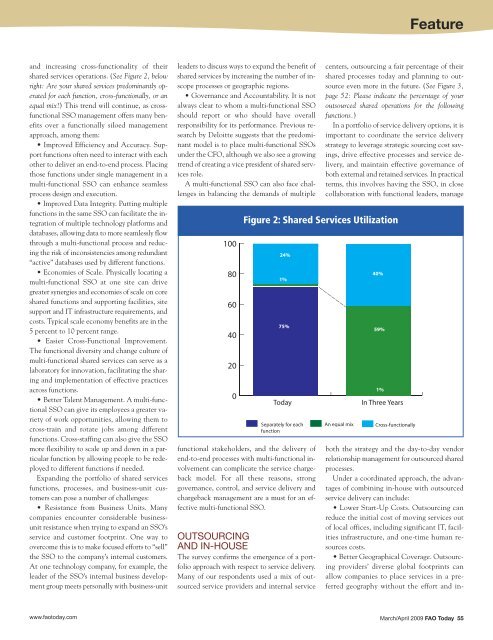March/April 2009 www.FAOToday.com
March/April 2009 www.FAOToday.com
March/April 2009 www.FAOToday.com
Create successful ePaper yourself
Turn your PDF publications into a flip-book with our unique Google optimized e-Paper software.
Feature<br />
and increasing cross-functionality of their<br />
shared services operations. (See Figure 2, below<br />
right: Are your shared services predominantly operated<br />
for each function, cross-functionally, or an<br />
equal mix?) This trend will continue, as crossfunctional<br />
SSO management offers many benefits<br />
over a functionally siloed management<br />
approach, among them:<br />
• Improved Efficiency and Accuracy. Support<br />
functions often need to interact with each<br />
other to deliver an end-to-end process. Placing<br />
those functions under single management in a<br />
multi-functional SSO can enhance seamless<br />
process design and execution.<br />
• Improved Data Integrity. Putting multiple<br />
functions in the same SSO can facilitate the integration<br />
of multiple technology platforms and<br />
databases, allowing data to more seamlessly flow<br />
through a multi-functional process and reducing<br />
the risk of inconsistencies among redundant<br />
“active” databases used by different functions.<br />
• Economies of Scale. Physically locating a<br />
multi-functional SSO at one site can drive<br />
greater synergies and economies of scale on core<br />
shared functions and supporting facilities, site<br />
support and IT infrastructure requirements, and<br />
costs. Typical scale economy benefits are in the<br />
5 percent to 10 percent range.<br />
• Easier Cross-Functional Improvement.<br />
The functional diversity and change culture of<br />
multi-functional shared services can serve as a<br />
laboratory for innovation, facilitating the sharing<br />
and implementation of effective practices<br />
across functions.<br />
• Better Talent Management. A multi-functional<br />
SSO can give its employees a greater variety<br />
of work opportunities, allowing them to<br />
cross-train and rotate jobs among different<br />
functions. Cross-staffing can also give the SSO<br />
more flexibility to scale up and down in a particular<br />
function by allowing people to be redeployed<br />
to different functions if needed.<br />
Expanding the portfolio of shared services<br />
functions, processes, and business-unit customers<br />
can pose a number of challenges:<br />
• Resistance from Business Units. Many<br />
<strong>com</strong>panies encounter considerable businessunit<br />
resistance when trying to expand an SSO’s<br />
service and customer footprint. One way to<br />
over<strong>com</strong>e this is to make focused efforts to “sell”<br />
the SSO to the <strong>com</strong>pany’s internal customers.<br />
At one technology <strong>com</strong>pany, for example, the<br />
leader of the SSO’s internal business development<br />
group meets personally with business-unit<br />
leaders to discuss ways to expand the benefit of<br />
shared services by increasing the number of inscope<br />
processes or geographic regions.<br />
• Governance and Accountability. It is not<br />
always clear to whom a multi-functional SSO<br />
should report or who should have overall<br />
responsibility for its performance. Previous research<br />
by Deloitte suggests that the predominant<br />
model is to place multi-functional SSOs<br />
under the CFO, although we also see a growing<br />
trend of creating a vice president of shared services<br />
role.<br />
A multi-functional SSO can also face challenges<br />
in balancing the demands of multiple<br />
100<br />
80<br />
60<br />
40<br />
20<br />
0<br />
functional stakeholders, and the delivery of<br />
end-to-end processes with multi-functional involvement<br />
can <strong>com</strong>plicate the service chargeback<br />
model. For all these reasons, strong<br />
governance, control, and service delivery and<br />
chargeback management are a must for an effective<br />
multi-functional SSO.<br />
OUTSOURCING<br />
AND IN-HOUSE<br />
The survey confirms the emergence of a portfolio<br />
approach with respect to service delivery.<br />
Many of our respondents used a mix of outsourced<br />
service providers and internal service<br />
centers, outsourcing a fair percentage of their<br />
shared processes today and planning to outsource<br />
even more in the future. (See Figure 3,<br />
page 52: Please indicate the percentage of your<br />
outsourced shared operations for the following<br />
functions.)<br />
In a portfolio of service delivery options, it is<br />
important to coordinate the service delivery<br />
strategy to leverage strategic sourcing cost savings,<br />
drive effective processes and service delivery,<br />
and maintain effective governance of<br />
both external and retained services. In practical<br />
terms, this involves having the SSO, in close<br />
collaboration with functional leaders, manage<br />
Figure 2: Shared Services Utilization<br />
24%<br />
24%<br />
1%<br />
75%<br />
Today<br />
Separately for each<br />
function<br />
An equal mix<br />
40%<br />
59%<br />
1%<br />
In Three Years<br />
Cross-functionally<br />
both the strategy and the day-to-day vendor<br />
relationship management for outsourced shared<br />
processes.<br />
Under a coordinated approach, the advantages<br />
of <strong>com</strong>bining in-house with outsourced<br />
service delivery can include:<br />
• Lower Start-Up Costs. Outsourcing can<br />
reduce the initial cost of moving services out<br />
of local offices, including significant IT, facilities<br />
infrastructure, and one-time human resources<br />
costs.<br />
• Better Geographical Coverage. Outsourcing<br />
providers’ diverse global footprints can<br />
allow <strong>com</strong>panies to place services in a preferred<br />
geography without the effort and in-<br />
<strong>www</strong>.faotoday.<strong>com</strong><br />
<strong>March</strong>/<strong>April</strong> <strong>2009</strong> FAO Today 55
















